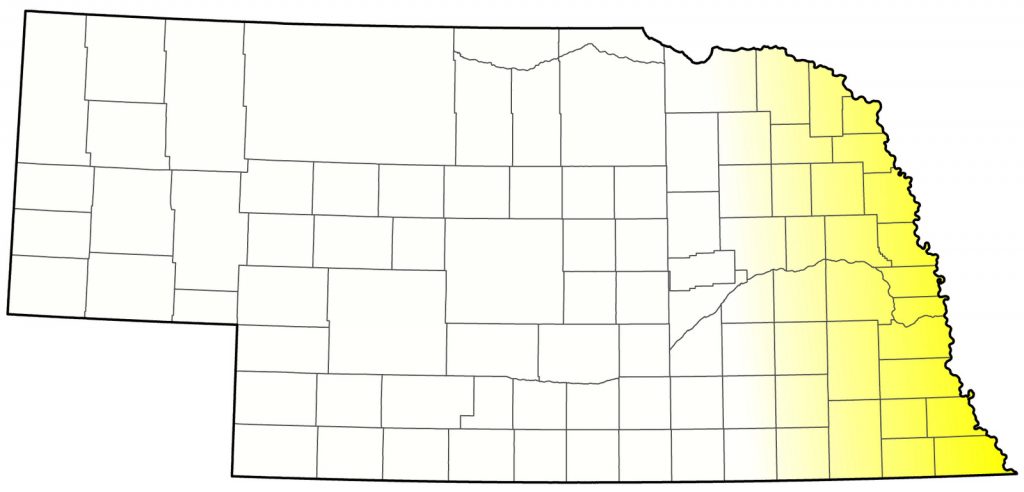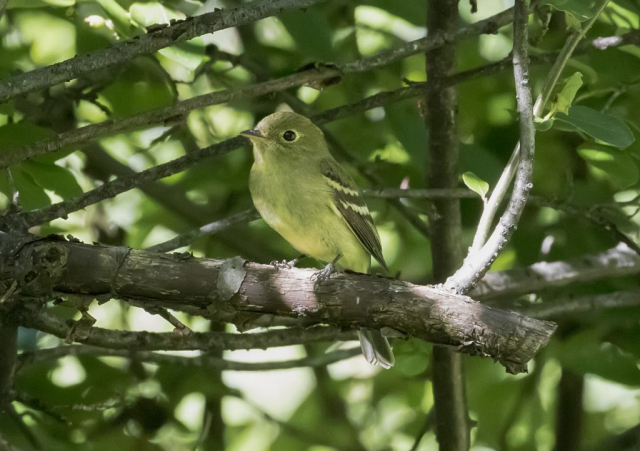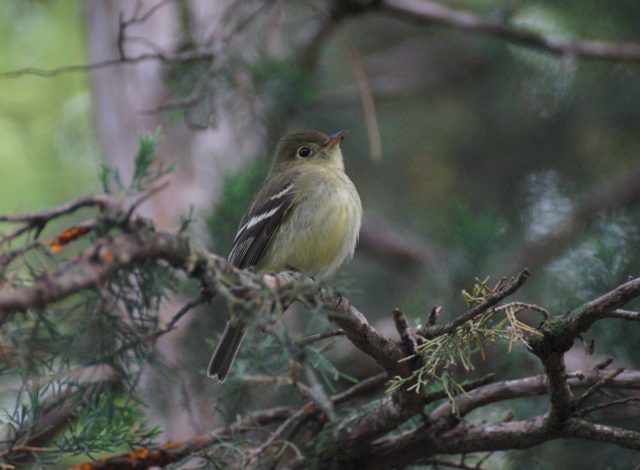Empidonax flaviventris
Status: Rare regular spring migrant east, rare casual central and west. Rare regular fall migrant east, rare casual central.

Documentation: Specimen: WSC 1027, 13 Sep 1982 Albion, Boone Co.
Taxonomy: No subspecies are recognized (AviList 2025).
Spring: May 10, 11, 11 <<<>>> Jun 3, 3 (Silcock 2001), 3 (Brown et al 1996)
Earlier dates (photographed) are 7 May 1985 Dixon Co, and 8 May 2018 Sarpy Co. There are several documented spring records 16-20 May, including one banded at Lake Ogallala, Keith Co 18 May 1996 (Brown et al 1996). Documented Kansas records are in the period 4 May-5 Jun (Thompson et al 2011), and early dates in Iowa are May 4, 7, and 7 (Kent and Dinsmore 1996).
Later dates are 8 Jun 2006 Cass Co, and 8 Jun 2011 Sarpy Co (see Comments, below).
Migration peaks in late May; six were reported 21-28 May in eastern Nebraska in 2013 and again 10-31 May 2017, an unusually high tally, although at least 11 were reported in 2020, probably as observers become more familiar with this species. Quite amazing was a major influx in 2025, when about 59 were reported 20 May-3 Jun; eight in all were found at three Dodge Co locations 3 Jun.
The westernmost reports, including only three for the Panhandle, are 12-13 May 1973 Thomas Co (Bray 1994), 16 May 1911 Lincoln Co (Tout 1947), 24 May 2022 Fort Robinson SP, Dawes Co, 31 May 2024 Fort Robinson SHP, Dawes Co, one seen and heard 3 Jun 2001 at Crescent Lake NWR, Garden Co (Silcock 2001), one recorded at Rock Creek SRA, Dundy Co 18 Jun 2025, and individuals banded at Cedar Point Biological Station, Keith Co 18 May 1996 and 3 Jun 1992 (Brown et al 1996).
Tout (1947) carefully studied a male he had collected 16 May 1911 near North Platte, Lincoln Co until certain it was not a “Western Flycatcher”.
Fall: Aug 21, 22, 23 <<<>>> Sep 13, 14, 14
Earlier dates are 31 Jul 2025 at Wayne, Wayne Co, 31 Jul 2025 at DeSoto NWR, Washington Co, 1 Aug 2024 Douglas Co, 8 Aug 2004 banded Boyer Chute NWR, Washington Co, 12 Aug 2016 Richardson Co, 14 Aug 2012 Washington Co, and 19 Aug 2009 Richardson Co.
Later dates are 17 Sep 2020 Douglas Co, 18 Sep 2017 Douglas Co, 22 Sep 2015 Douglas Co, and 23 Sep 2003 Knox Co (see Comments).
The only Panhandle record is of one at Gotte Park, Kimball, Kimball Co 2 Sep 2020, although there are two records from Keith Co, singles at Lake Ogallala 26 Aug 2006 (Silcock 2006) and 3 Sep 2019.
Comments: There are a few reports for Jun and Jul which have been thought to indicate breeding, although this would be most unexpected. Yellow-bellied Flycatchers were reported in summer from Lancaster and Sarpy Cos in the years 1978-1981, including three nest cards for Sarpy Co submitted in 1978 (Bennett 1980). No identification details were published, but field notes made by the observer were subsequently located and examined; although the sightings appear to have been of a yellowish Empidonax flycatcher, the details did not allow positive identification of the birds; nothing in the notes suggests anything other than a Willow Flycatcher (Mollhoff 2004). A female netted in Sarpy Co 1 Jun and seen again 5 Jun 1978 had a “large brood patch” thought to be “indicative of nesting in the area” (Green 1978, Williams 1978); it was probably a migrant. A report of a pair with young near Bennet, Lancaster Co observed 8 Jul-10 Sep 1978 (Bennett 1980) was not conclusively identified from the observer’s field notes (Mollhoff 2004, 2022). One was reported in Omaha 16 Jun 1998, but it was singing a two-note song with the first note “wheezy” and the second clear (Ruth Phipps, personal communication), suggestive of an odd Willow Flycatcher; the report was not accepted by NOURC (Brogie 1999).
One was reported as banded 9 Oct 1992 in Sarpy Co (Morris 1993), although no description was provided. One in Omaha 22 Oct 2015 that was confirmed by “outside experts” as this species from photographs, was, however, not accepted by NOURC based on the perceived lack of quality of the video and an inconclusive written report (Brogie 2016).
Images
Abbreviations
NOURC: Nebraska Ornithologists’ Union
NWR: National Wildlife Refuge
SP: State Park
WSC: Wayne State College
Literature Cited
AviList Core Team, 2025. AviList: The Global Avian Checklist, v2025. https://doi.org/10.2173/avilist.v2025.
Bennett, E.V. 1980. 1978 Nebraska nesting survey. NBR 48:39-43.
Bray, T.E. 1994. Habitat utilization by birds in a man-made forest in the Nebraska Sandhills. Master’s thesis, University of Nebraska-Omaha, Omaha, Nebraska, USA.
Brogie, M.A. 1999. 1998 (Tenth) Report of the NOU Records Committee. NBR 67: 141-152.
Brogie, M.A. 2016. 2015 (27th) Report of the NOU Records Committee. NBR 84: 138-150.
Brown, C.R., M.B. Brown, P.A. Johnsgard, J. Kren, and W.C. Scharf. 1996. Birds of the Cedar Point Biological Station area, Keith and Garden Counties, Nebraska: Seasonal occurrence and breeding data. Transactions of the Nebraska Academy of Sciences 23: 91-108.
Green, R.C. 1978. Yellow-bellied Flycatcher. NBR 46: 86.
Kent, T.H., and J.J. Dinsmore. 1996. Birds in Iowa. Publshed by the authors, Iowa City and Ames, Iowa, USA.
Mollhoff, W.J. 2004. The 2002 Nebraska Nesting Report. NBR 72: 153-158.
Mollhoff, W.J. 2022. Nest records of Nebraska birds. Nebraska Ornithologists’ Union Occasional Paper Number 9.
Morris, R. 1993. Fall 1992 Occurrence Report (July 1 – December 31). NBR 61: 31-87.
Silcock, W.R. 2001. Summer Field Report, June and July 2001. NBR 69: 106-132.
Silcock, W.R. 2006. Fall Field Report, August-November 2006. NBR 74: 110-128.
Thompson, M.C., C.A. Ely, B. Gress, C. Otte, S.T. Patti, D. Seibel, and E.A. Young. 2011. Birds of Kansas. University Press of Kansas, Lawrence, Kansas, USA.
Tout, W. 1947. Lincoln County birds. Published by the author, North Platte, Nebraska, USA.
Williams, F. 1978. Southern Great Plains Region. American Birds 32: 1178-1182.
Recommended Citation
Silcock, W.R., and J.G. Jorgensen. 2025. Yellow-bellied Flycatcher (Empidonax flaviventris). In Birds of Nebraska — Online. www.BirdsofNebraska.org
Birds of Nebraska – Online
Updated 25 Aug 2025


